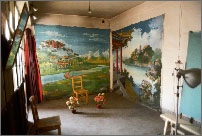May 2, 2006
Consider the Lettuce Maker
In Japan most restaurants feature lifelike plastic displays of the the various items on the menu. Low end restaurants use prefabricated dishes heaped with noodles or sushi or veggies, but better restaurants will actually have their dishes custom sculpted. The realism is startling. Soups practically shimmer, rice is slightly wet as if fresh from the pot, edamame come complete with plastic fuzz. At a Mexican restaurant in Osaka a display of tortilla chips featured individually molded pieces complete with a slight dust of salt. Artificial noodles sometimes drip from their bowls onto plates. American places show hamburgers complete with individual plastic sesame seeds on the bun. I asked everyone I knew about how such individualized displays were made. "Plastic food is art and science," my friend Daiki explained. He told me of high end studios where apprentice artists worked their way up from the lowly lettuce to American food and finally to fish and octopus. "Of course only masters create delicious looking octopus."
A few years ago while in Tokyo I sought out one of the most famous studios in the Kappabashi district and managed to talk my way in. Specifically I wanted see the apprentice lettuce makers in action, and after some confusion I was led by a secretary to a big windowless room full of small desks with men and women hunched over them. Over in the back sat an old man wearing a dirty smock over a dark suit, his workspace covered with paint tins, bits of plastic, and sharp modeling knives. Several pieces of lettuce in various states of completion had been carefully positioned on a plate. Before I could get started in precise English he explained, "to you, all lettuce looks same, but variety is infinite and each piece is unique. Our competitors try to copy life perfectly which is of course impossible. They make molds. Ha! I look at these an am ashamed. We do not even look at photographs. Our employees visit restaurant, eat each dish without taking notes. Afterwards our memory is the guide. We return to eat if we forget this thing or that. For lettuce to look like lettuce or fish to look like fish it must be better than reality but it also must be imperfect. This is the most important thing. If you make things perfect of course they will look fake. Think of American women and their plastic breasts. Of course breasts are never the same size! "
I asked how long he had been making lettuce. "36 years" was the quiet answer. I asked if he ever wished to do something else (a woman nearby was putting the finishing touches on a pastry that looked like a jelly donut). Of course I am a master, once I made a snake for a Chinese restaurant so full of life it was removed from the window for scaring customers, but lettuce is my passion. I would never start an artist on lettuce. Only someone with years of experience can get it right. Our artists start with rice which not easy, rice is just as difficult as anything else, but people are easily fooled with rice. And then maybe they move on to meat. Only then do sit with me and learn lettuce."
"And then they go on to fish," I added helpfully...
"After lettuce they can do anything," he smiled.



05/03/06 06:02 AM
Anonymous said...
:)